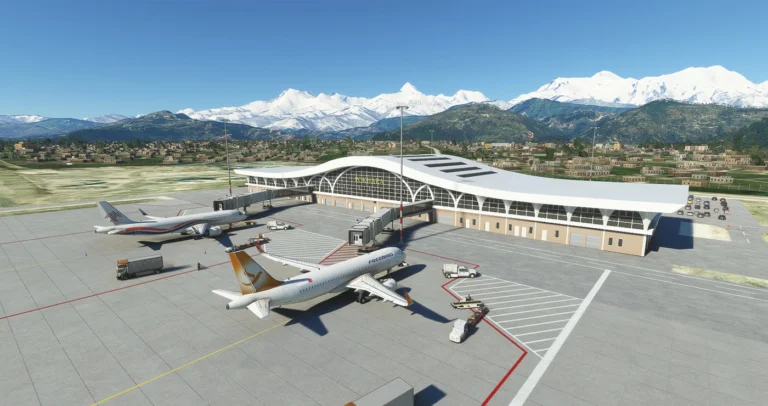Pokhara, Nepal – After 26 months since its inauguration, Pokhara International Airport has commenced regular international flights. Himalaya Airlines launched its scheduled Lhasa–Pokhara–Lhasa flight service on Monday, operating once a week.
Previously, international charter flights had been conducted to China, India, and Bhutan. Most recently, Sichuan Airlines had been operating commercial charter flights on the Chengdu–Pokhara route. On Monday, Himalaya Airlines’ aircraft departed from Lhasa Gonggar Airport at 2:39 PM local time in China and landed in Pokhara at 1:56 PM Nepali time, completing a 1-hour-34-minute flight with 107 passengers. Among them, 32 were Chinese nationals, while 75 were Nepali citizens.
The inaugural flight passengers were welcomed by Gandaki Province Chief Minister Surendra Raj Pandey, Minister of State for Culture, Tourism, and Civil Aviation Arun Kumar Chaudhary, Pokhara Metropolitan Mayor Dhanraj Acharya, Chinese Ambassador to Nepal Chen Song, and officials from Himalaya Airlines. The aircraft remained in Pokhara overnight and departed for Lhasa at 8:20 AM on Tuesday, landing at 12:05 PM local time in China. This weekly schedule will continue, with plans to expand services based on demand. The airline aims to integrate the Kathmandu–Lhasa–Pokhara–Lhasa–Kathmandu sector and increase flights in the future.
At the inaugural ceremony, Chief Minister Pandey emphasized the significance of connectivity in promoting tourism in Gandaki Province. He praised Himalaya Airlines for choosing Pokhara as a destination but acknowledged the challenges of sustaining regular flights. “Despite existing challenges, government support can help address them. The Gandaki government is committed to facilitating and expanding Himalaya Airlines’ operations in Pokhara,” he stated. He also encouraged the airline to attract international tourists traveling to Lhasa to visit Pokhara.
State Minister for Tourism Chaudhary expressed confidence that the airline would expand its flight schedule in the future. Chinese Ambassador Chen Song expressed his happiness at the launch of the regular commercial service, noting that Pokhara residents’ dream of having an international airport was fulfilled two years ago, and now, their aspiration for regular international flights had become a reality.
Pokhara Metropolitan Mayor Acharya highlighted that the Lhasa–Pokhara flight would strengthen Nepal–China relations and facilitate travel for pilgrims visiting Mount Kailash via Lhasa. With Pokhara declared as Nepal’s tourism capital and its Visit Pokhara Year 2025 campaign underway, the new flight is expected to be a milestone in boosting tourism.
Himalaya Airlines Chairman Zhou Enyong described the Lhasa–Pokhara route as a significant achievement for Nepal’s aviation industry. “This flight establishes Pokhara as a key international gateway and enhances regional air connectivity,” he said. “Beyond being a new route, it strengthens Nepal–China relations, promotes tourism, and creates new opportunities for trade and cultural exchange.”
Recalling that Himalaya Airlines had also landed the first international aircraft during Pokhara International Airport’s inauguration, Deputy Director General of the Civil Aviation Authority of Nepal (CAAN), Devchandra Lal Karna, expressed satisfaction that the first regular international flight was also operated by the same airline. “With CAAN’s efforts, we have started scheduled international flights. Now, we must work towards ensuring their sustainability,” he remarked. “If these flights fail, it would be unfortunate for us, Pokhara residents, and Himalaya Airlines alike.” He noted that Himalaya Airlines has gained Pokhara as a new market and destination.
Himalaya Airlines Vice President and Spokesperson Vijay Shrestha emphasized the need for collaboration between CAAN, the airline, provincial authorities, and local government to sustain the flights. Referring to Gautam Buddha International Airport, where airlines faced financial losses, he stressed that Pokhara’s success would depend on adequate passenger demand. “Our primary objective is to operate flights to 10 key tourist destinations in China and bring one million Chinese tourists to Nepal annually,” he stated.



 About Us
About Us
Comment